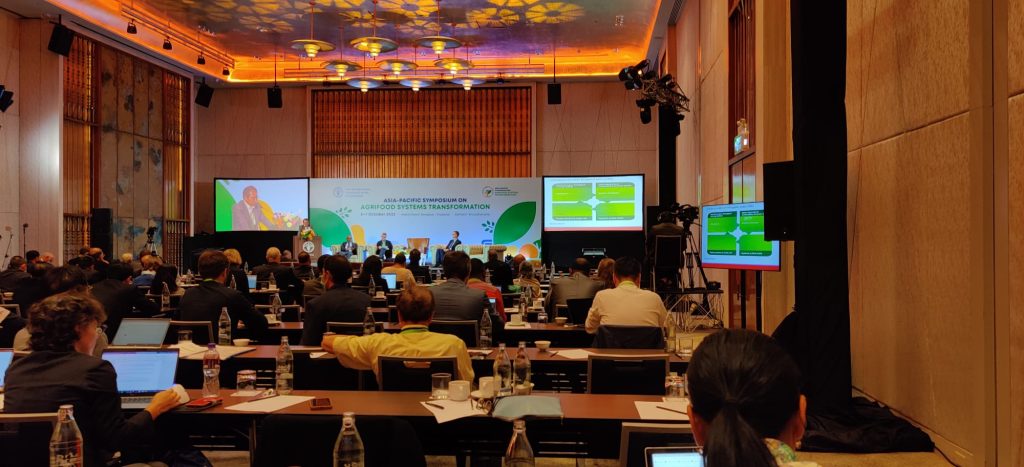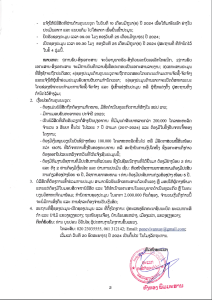ບັນດາປະເທດອາຊີປາຊີຟິກຮຽກຮ້ອງໃຫ້ຫັນປ່ຽນລະບົບອາຫານກະສິກຳໂດຍໄວ ເນື່ອງຈາກຄວາມຫວັງຈະສູນຫາຍໄປໃນການບັນລຸເປົ້າໝາຍພັດທະນາແບບຍືນຍົງໃນປີ 2030/Asia-Pacific countries urged to rapidly transform agrifood systems as hopes fade for achieving the Sustainable Development Goals by 2030
[English below]

ບັນດາປະເທດອາຊີປາຊີຟິກຮຽກຮ້ອງໃຫ້ຫັນປ່ຽນລະບົບອາຫານກະສິກຳໂດຍໄວ ເນື່ອງຈາກຄວາມຫວັງຈະສູນຫາຍໄປໃນການບັນລຸເປົ້າໝາຍພັດທະນາແບບຍືນຍົງໃນປີ 2030.
ອົງການອາຫານ ແລະ ການກະເສດແຫ່ງສະຫະປະຊາຊາດ (FAO) ຮຽກຮ້ອງໃຫ້ສຸມໃສ່ການຄຸ້ມຄອງສັງຄົມ, ການເຂົ້າເຖິງແນວພັນພືດ ແລະ ຝຸ່ນ, ການປັບປຸງການຄ້າ ແລະ ກະສິກໍາ ທີ່ທົນທານຕໍ່ກັບການປ່ຽນແປງດິນຟ້າອາກາດ ໃນກອງປະຊຸມອາຊີ-ປາຊີຟິກ.
ວັນທີ 05/10/2022, ທີ່ບາງກອກ
ໃນກອງປະຊຸມທີ່ຈັດຂຶ້ນໂດຍອົງການອາຫານ ແລະ ການກະເສດແຫ່ງສະຫະປະຊາຊາດ (FAO) ກ່ຽວກັບການຫັນປ່ຽນລະບົບກະສິກຳໃນອາຊີ-ປາຊີຟິກ, ລັດຖະບານ, ພາກເອກະຊົນ ແລະ ພາກສ່ວນກ່ຽວຂ້ອງອື່ນໆ ໄດ້ຮຽກຮ້ອງໃຫ້ເລັ່ງລັດການຫັນ ປ່ຽນລະບົບກະສິກຳຂອງຕົນຢ່າງຫຼວງຫຼາຍ ຫຼື ສ່ຽງຕໍ່ການຂາດສານອາຫານ ແລະ ການເຊື່ອມໂຊມຂອງສິ່ງແວດລ້ອມ ຢູ່ໃນພາກພື້ນທີ່ມີປະຊາກອນຫຼາຍທີ່ສຸດໃນໂລກ.
ການເພີ່ມຂຶ້ນຂອງລາຄາອາຫານ, ໄພນໍ້າຖ້ວມ, ໄພແຫ້ງແລ້ງ, ການຂາດແຄນນ້ໍາ, ໄພພິບັດທີ່ກ່ຽວຂ້ອງກັບສະພາບອາກາດທີ່ເພີ່ມຂຶ້ນ, ພະຍາດລະບາດ ແລະ ຄວາມຂັດແຍ້ງ, ກໍາລັງເຮັດໃຫ້ເກີດຄວາມບໍ່ໝັ້ນຄົງທາງດ້ານອາຫານໃນພາກພື້ນ. ສິ່ງທ້າທາຍເຫຼົ່ານີ້ສົ່ງຜົນກະທົບໂດຍກົງຕໍ່ປະຊາຊົນທີ່ມີຄວາມສ່ຽງທີ່ສຸດ, ລວມທັງຊາວກະສິກອນຂະໜາດນ້ອຍ ພົບກັບຄວາມຫຍຸ້ງຍາກ ສໍາລັບການດໍາລົງຊີວິດຂອງເຂົາເຈົ້າ ແລະ ຫຼາຍລ້ານຄົນທີ່ທຸກຍາກໃນເຂດຕົວເມືອງ.
ການປ່ຽນແປງຮູບແບບຂອງນ້ຳຝົນ, ສິ່ງສຳຄັນສຳລັບການກະສິກຳໃນເຂດມໍລະສຸມ, ຄວາມຖີ່ ແລະ ໄລຍະເວລາການລະບາດຂອງສັດຕູພືດ ແລະ ພະຍາດໄດ້ລວມເຂົ້າກັນ ເຮັດໃຫ້ຜົນຜະລິດຕ່ຳ. ອາຊີ ແລະ ປາຊີຟິກ 60 ເປີເຊັນ ແມ່ນປະສົບກັບການເສຍຊີວິດທົ່ວໂລກ ແລະ 40 ເປີເຊັນ ຂອງການສູນເສຍທາງດ້ານເສດຖະກິດ ເນື່ອງຈາກໄພອັນຕະລາຍ ແລະ ຄວາມສ່ຽງຫຼາຍດ້ານ.
ສະຫຼຸບແລ້ວ, ລະບົບກະສິກຳທີ່ສັບສົນຂອງພາກພື້ນ ແມ່ນຢູ່ພາຍໃຕ້ຄວາມເຄັ່ງຕຶງອັນໃຫຍ່ຫຼວງ.
ພາກພື້ນອາຊີ-ປາຊີຟິກ ເປັນຄັ້ງທຳອິດອອກຈາກປະຕູສູ່ພາຍນອກ ຫຼັງກອງປະຊຸມສຸດຍອດລະບົບອາຫານຂອງສະຫະປະຊາຊາດ.
ໃນປີ 2021 ທີ່ຜ່ານມາ, ຕົກຢູ່ໃນສະພາບການລະບາດໃຫຍ່ໃນທົ່ວໂລກ, ຜູ້ນຳລະດັບໂລກໃຫ້ຄຳໝັ້ນສັນຍາ ວ່າຈະຫັນ ປ່ຽນລະບົບອາຫານທາງກະສິກຳຂອງພວກເຂົາ ເພື່ອເຮັດໃຫ້ມີປະສິດທິພາບຫຼາຍຂຶ້ນ, ປົກຄຸມ, ທົນທານ ແລະ ຍືນຍົງ.
ທ່ານ QU Dongyu ຫົວໜ້າອົງການ FAO ໄດ້ກ່າວໃນຕອນຕົ້ນຂອງການປະຊຸມສຳມະນາດ້ານລະບົບອາຫານ ແຫ່ງສະຫະປະຊາຊາດ ເຊິ່ງຈັດຂຶ້ນເປັນຄັ້ງທຳອິດຂອງໂລກ ເປັນເວລາ 3 ວັນ ໂດຍມີເປົ້າໝາຍເພື່ອປ່ຽນແປງລະບົບອາຫານທາງການກະສິກຳຢ່າໄວວາ ໃນພູມມີພາກອັນກວ້າງໃຫຍ່ນີ້ ຈຳເປັນຕ້ອງວາງເປົ້າໃສ່ທີ່ຜົນໄດ້ຮັບທີ່ສົ່ງຜົນໃຫ້ຜົນຜະລິດດີຂຶ້ນ ໂພຊະນາການທີ່ດີຂຶ້ນ ສະພາບແວດລ້ອມທີ່ດີຂຶ້ນ ແລະ ຊີວິດທີ່ດີຂຶ້ນ ສຳລັບທຸກຄົນ ເພື່ອໃຫ້ແນ່ໃຈວ່າບໍ່ມີໃຜຖືກຖິ້ມໄວ້ທາງຫຼັງ.
FAO ໄດ້ສ້າງແຜນທີ່ 4 ຂົງເຂດບູລິມະສິດທີ່ຕ້ອງການເລັ່ງລັດ ເຊັ່ນ:
- ໃຫ້ການຊ່ວຍເຫຼືອທັນທີແກ່ຜູ້ດ້ອຍໂອກາດ ໂດຍຜ່ານລະບົບການຄຸ້ມຄອງທາງສັງຄົມ ໂດຍສະເພາະໃນເຂດຊົນນະບົດ ແລະ ກຸ່ມທີ່ມີຄວາມສ່ຽງ;
- ຊຸກຍູ້ການຜະລິດກະສິກຳ ໂດຍຮັບປະກັນວ່າຄອບຄົວຊາວກະສິກອນ ສາມາດເຂົ້າເຖິງແນວພັນ ແລະ ຝຸ່ນໄດ້ ໃນລາຄາທີ່ບໍ່ແພງ, ມີເງິນທຶນໝູນວຽນ, ໄດ້ຮັບການຊ່ວຍເຫຼືອທາງດ້ານເຕັກນິກ ແລະ ການເຊື່ອມໂຍງເຂົ້າກັບຕະຫຼາດ;
- ອຳນວຍຄວາມສະດວກໃຫ້ແກ່ກຜະລິດຕະພັນກະສິກຳ ແລະ ປັດໃຈການຜະລິດ ເພື່ອບໍ່ໃຫ້ເກີດການຢຸດສະງັກໃນການຜະລິດອາຫານ; ແລະ
- ການລົງທຶນເຂົ້າໃນການຜະລິດກະສິກຳທີ່ຍືນຍົງ ຕໍ່ການປ່ຽນແປງສະພາບດິນຟ້າອາກາດ, ເພື່ອແກ້ໄຂ ແລະ ຫັນຜົນກະທົບຈາກວິກິດການດິນຟ້າອາກາດ.
ຜູ້ອຳນວຍການໃຫຍ່ໄດ້ເຕືອນວ່າ: ເປົ້າໝາຍການພັດທະນາແບບຍືນຍົງ ຫຼື SDG ຈະບໍ່ສາມາດບັນລຸໄດ້ ເວັ້ນເສຍແຕ່ວ່າ ມີເຈດຕະນາລວມ ເພື່ອເອົາຊະນະຄວາມອຶດຫິວ ເປັນບູລິມະສິດໃນພາກພື້ນພາຍຫຼັງພະຍາດລະບາດ.
ວິກິດການຢ່າງຕໍ່ເນື່ອງ, ລວມທັງຜົນກະທົບຂອງ COVID-19, ວິກິດການດິນຟ້າອາກາດ, ໄພແຫ້ງແລ້ງ ແລະ ໄພນໍ້າຖ້ວມ, ຄວາມຂັດແຍ້ງ ແລະ ສົງຄາມ ໄດ້ສົ່ງຜົນຕໍ່ການສະໝອງເມັດພັນພືດ ແລະ ສິນຄ້າ ທີ່ຈໍາເປັນອື່ນໆຂອງໂລກ, ທ່ານ QU Dongyu ສັງເກດເຫັນວ່າ: ຜົນໄດ້ຮັບ ແມ່ນ “ເສດຖະກິດຕົກຕໍ່າ ແລະ ການສູນເສຍວຽກເຮັດງານທໍາ ທີ່ຝັກດັນໃຫ້ການຂາດສານອາຫານ ຈາກ 8% ເປັນເກືອບ 10% ໃນປີທໍາອິດຂອງການແຜ່ລະບາດ, ດ້ວຍຈໍານວນຜູ້ຂາດສານອາຫານທີ່ເພີ່ມຂຶ້ນໃນປັດຈຸບັນ ແມ່ນ 150 ລ້ານຄົນ. ສ່ວນໃຫຍ່ຂອງການເພີ່ມຂຶ້ນນີ້ ແມ່ນຢູ່ໃນອາຊີ ແລະ ປາຊີຟິກ, ເຊິ່ງກວມເອົາເກືອບ 85 ລ້ານຄົນທີ່ອຶດຫິວ, ເຊັ່ນດຽວກັນກັບໃນອາຟຣິກາ ແລະ ອາເມລິກາລາຕິນ“, ຜູ້ອໍານວຍການ FAO ກ່າວວ່າ: “ເພື່ອບັນລຸ SDGs ພວກເຮົາຕ້ອງການ ການຫັນປ່ຽນທີ່ສໍາຄັນ – ໜຶ່ງ: ເລີ່ມຕົ້ນດ້ວຍການຫັນປ່ຽນລະບົບກະສິກໍາຂອງພວກເຮົາ ເພື່ອຮັບປະກັນວ່າ: ພວກເຂົາສາມາດຕອບສະຫນອງຄວາມຕ້ອງການໃນປັດຈຸບັນ ແລະ ອະນາຄົດຂອງຜູ້ມີສ່ວນຮ່ວມ ແລະ ຜູ້ບໍລິໂພກທັງຫມົດ”.
ພາກພື້ນອາຊີ-ປາຊີຟິກ ຖອຍຫລັງແບບອັນຕະລາຍ ຕໍ່ SDGs
ອີງຕາມບົດລາຍງານຄວາມຄືບໜ້າ ເປົ້າໝາຍການພັດທະນາແບບຍືນຍົງ ຂອງອາຊີ ແລະ ປາຊີຟິກ ປີ 2022 ຂອງອົງການສະຫະປະຊາຊາດພາກພື້ນອາຊີ ແລະ ປາຊີຟິກ ແມ່ນບໍ່ແນ່ນອນ, ຮອດປີ 2065 ເພື່ອບັນລຸເປົ້າໝາຍການພັດທະນາແບບຍືນຍົງທັງໝົດ 17 ເປົ້າໝາຍທີ່ຊັກຊ້າໄປ 35 ປີ.
ການຫຍຸດສະງັກຂອງລະບົບຕ່ອງໂສ້ການສະໜອງ, ຊີວິດ ແລະ ການດຳລົງຊີວິດທີ່ຜ່ານມາ ເຊິ່ງໄດ້ສົ່ງຜົນກະທົບ 5 Fs, ການຂາດອາຫານ, ອາຫານສັດ, ນໍ້າມັນເຊື້ອໄຟ, ຝຸ່ນ ແລະ ການເງິນ ແລະ ການຄາດຄະເນວ່າ: ຜົນຜະລິດກະສິກຳໃນປີໜ້າ ເນື່ອງມາຈາກປັນຫາການຂາດແຄນຝຸ່ນ ຂອງບາງປະເທດໃນພາກພື້ນ.
ເຖິງຢ່າງໃດກໍ່ຕາມ, ການຫຼຸດລົງເກີດຂຶ້ນກ່ອນ ບໍ່ວ່າຈະເປັນພະຍາດລະບາດ, ດ້ວຍການຕີພິມຂ່າວເຜີຍແຜ່ປະຈໍາປີຂອງ FAO ຢ່າງຕໍ່ເນື່ອງ, ສະຖານະຄວາມໝັ້ນຄົງທາງດ້ານສະບຽງອາຫານ ແລະ ໂພຊະນາການ ເຕືອນວ່າ: ການສູ້ກັບໄພອຶດຫິວ ແລະ ການຂາດສານອາຫານ ກຳລັງເກີດຂໍ້ຜິດພາດໃນພາກພື້ນນີ້. ໃນປີ 2021 ປະຊາກອນຫຼາຍກວ່າ 400 ລ້ານຄົນ ໃນພາກພື້ນອາຊີ-ປາຊີຟິກ ຂາດສານອາຫານ ສ່ວນໃຫຍ່ຢູ່ໃນພາກພື້ນອາຊີໃຕ້ ໂດຍ 40% ຂອງປະຊາກອນທີ່ຢູ່ອາໃສທັງໝົດ ບໍ່ສາມາດກິນອາຫານທີ່ມີປະໂຫຍດຕໍ່ຮ່າງກາຍ.
ໃນອາຊີ ແລະ ປາຊີຟິກ, ເຖິງເວລາແລ້ວທີ່ຈະເລັ່ງການປ່ຽນແປງ ລະບົບອາຫານທາງການກະສິກຳ ເພື່ອບໍ່ໃຫ້ໃຜຢູ່ທາງຫຼັງ.
ຫຼາຍກວ່າ 80% ຂອງຊາວກະສິກອນຂະໜາດນ້ອຍ ແລະ ຄອບຄົວຊາວກະສິກອນຂອງໂລກ ອາໄສຢູ່ນອກພື້ນທີ່ໃນພາກພື້ນອາຊີ-ປາຊີຟິກນີ້ ແລະ ກອງປະຊຸມສຳມະນາ ໄດ້ຖືກບອກເຖິງຜົນປະໂຫຍດ ແລະ ຊີວິດການເປັນຢູ່ຂອງເຂົາເຈົ້າ ຕ້ອງໄດ້ຮັບການປົກປ້ອງຈາກມາດຕະການຕ່າງໆ ລວມທັງຕາໜ່າງຄວາມປອດໄພທາງສັງຄົມ ແລະໂຄງການຟື້ນຟູຊີວິດການເປັນຢູ່ ເພື່ອປັບປຸງໂອກາດໃນດ້ານການຈ້າງງານ. FAO ຮຽກຮ້ອງໃຫ້ຜູ້ມີສ່ວນຮ່ວມທຸກຝ່າຍ ຫັນປ່ຽນລະບົບກະສິກຳຂອງພາກພື້ນ, ໂດຍກ່າວວ່າ: ລັດຖະບານຕ້ອງເປັນຜູ້ນຳ; ພາກເອກະຊົນຕ້ອງຂະຫຍາຍຖານລູກຄ້າໃຫ້ກວ້າງຂວາງ ເພື່ອແກ້ໄຂລາຄາທີ່ເໝາະສົມໃຫ້ແກ່ຊາວກະສິກອນຂະໜາດນ້ອຍ; ສັງຄົມຕ້ອງເຮັດວຽກຢ່າງຕັ້ງໜ້າກັບຜູ້ວາງນະໂຍບາຍ ແລະ ພາກເອກະຊົນ; ສະຖາບັນການສຶກສາຕ້ອງເລັ່ງໃສ່ການຄົ້ນຄວ້າ, ໃນຂະນະທີ່ຄູ່ຮ່ວມມືດ້ານຊັບພະຍາກອນ ຕ້ອງເຮັດໃຫ້ການຫັນປ່ຽນນີ້ເປັນບູລິມະສິດສູງສຸດຂອງພວກເຂົາ, ໂດຍ FAO ໃຫ້ຄໍາໝັ້ນສັນຍາທີ່ຈະຊ່ວຍໃຫ້ສະມາຊິກ ແລະ ຄູ່ຮ່ວມງານບັນລຸເປົ້າໝາຍເຫຼົ່ານີ້.
Asia-Pacific countries urged to rapidly transform agrifood systems as hopes fade for achieving the Sustainable Development Goals by 2030
FAO calls for focus on social protection, access to seeds and fertilizers, enhanced trade and climate-resilient agriculture at Asia-Pacific symposium.
05/10/2022 Bangkok
At a symposium convened by the Food and Agriculture Organization of the United Nations (FAO) on agrifood systems transformation in Asia-Pacific, governments, the private sector and other stakeholders are being urged to massively accelerate transformation of their agrifood systems, or risk worsening malnutrition and environmental degradation in the world’s most populous region.
Rising food prices, floods, drought, water scarcity, increasing climate-related disasters, the global pandemic and conflicts, are driving food insecurity across the region. These challenges directly impact the most vulnerable people, including smallholder farmers, others depending on the land for their livelihoods and millions of urban poor.
Changes in rainfall patterns, crucial for agriculture in the monsoon region and in the frequencies and timings of pest and disease outbreaks have combined to lower yields. Asia and the Pacific already experiences 60 percent of global fatalities and 40 percent of economic losses due to multiple hazards and risks.
In summary, the region’s complex agrifood systems are under enormous strain.
Asia-Pacific region first out of the gate following UN Food Systems Summit
Last year, caught in the grip of a global pandemic, world leaders pledged to transform their agrifood systems to make them more efficient, inclusive, resilient and sustainable.
Speaking at the beginning of a three-day Asia-Pacific symposium, the world’s first since the UN Food Systems Summit, which aims to fast-track agrifood systems transformation in this vast region, FAO’s Director-General, QU Dongyu, said the region’s transformation needs to focus on outcomes that result in better production, better nutrition, a better environment, and a better life for all – ensuring no one is left behind.
FAO has mapped out four priority areas in which acceleration is needed:
- Providing immediate support to the vulnerable through social protection systems, especially in rural areas and among vulnerable groups;
- Boosting agricultural production by ensuring that family farmers have affordable access to seeds and fertilizers, working capital and technical assistance, and links to markets;
- Facilitating trade in agricultural products and inputs to prevent further disruptions to food production; and
- Investing in climate-resilient agriculture to address and reverse the effects of the climate crisis.
The Director-General warned that the SDG’s would not be achievable unless there is a collective will to defeat hunger, as a priority, in a post-pandemic region.
Ongoing crises, including the impacts of COVID-19, the climate crisis, droughts and floods, conflicts and war have disrupted the world’s supply of grains and other essential commodities, Qu noted. The result is “economic downturns and loss of jobs that pushed undernourishment from eight percent to almost ten percent during the first year of the pandemic, with the number of undernourished that has now grown by 150 million. The majority of this increase is in Asia and the Pacific, accounting for nearly 85 million more people in hunger, as well as in Africa and Latin America,” the FAO Director-General said. “To achieve the SDGs we need a major transformation – one that begins with the transformation of our agrifood systems to ensure they can meet the present and future needs of all stakeholders and consumers.”
Asia-Pacific region dangerously backsliding on SDGs
According to the recent UN 2022 Asia and the Pacific Sustainable Development Goals Progress Report the region is so off course, it would need until 2065 to achieve all 17 Sustainable Development Goals – a delay of 35 years.
The recent disruption to supply chains, lives and livelihoods has come together to produce a crisis of five ‘Fs’ – lack of food, feed, fuel, fertilizer and finance, and a prediction that there could be reductions in cereal output next year due to fertilizer shortages in some countries in the region.
However, the backsliding predates even the pandemic, with successive annual editions of FAO’s flagship publication, the State of Food Security and Nutrition warning the fight against hunger and malnutrition was failing in this region. In 2021, more than 400 million people in Asia-Pacific were malnourished, most of them in South Asia, with 40 percent of all inhabitants unable to afford a healthy diet.
In Asia and the Pacific, now is the time to accelerate the agrifood systems transformation – to leave no one behind.
More than 80 percent of the world’s smallholders and family farmers live off the land in this Asia-Pacific region, and the Symposium was told their interests and livelihoods must be safeguarded by measures including social safety nets and reskilling programmes to improve employment prospects. FAO called for bold action by all stakeholders to transform the region’s agrifood systems, saying governments must provide leadership; the private sector must broaden its customer base to provide affordable solutions for smallholders; civil society must work more proactively with policymakers and the private sector; academia must accelerate research, while resource partners must make this transformation their top priority, with FAO committed to helping its Members and partners achieve these objectives.








